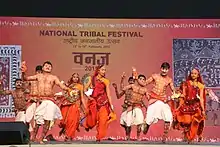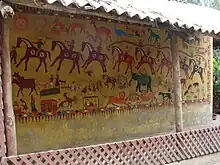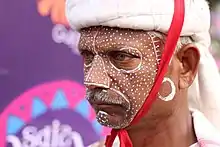Rathwa
The Rathva[3] or Rathwa[4] also spelled as Rathava[5] and Rathawa is a Subcaste of the Koli caste found in the Indian state of Gujarat.[6][7] Rathava Kolis were agriculturist by profession and turbulent by habits[5][8] but now lives like Adivasis such as Bhil because of their neighborhood[9]
.jpg.webp) | |
| Regions with significant populations | |
|---|---|
| 9200[1] | |
| 643,381[2] | |
| Gujarat | 642,348[2] |
| Madhya Pradesh | 500[2] |
| Maharashtra | 488[2] |
| Karnataka | 45[2] |
| Languages | |
| Rathwi, Gujarati, Hindi | |
| Religion | |
| Hinduism , Christianity | |
Classification
The Rathva Kolis were classified as Other Backward Class or OBC by Government of Gujarat[10] but in August 2022 reclassified as a Scheduled Tribes.[11]
History and origin
The Rathwa derive their name from the word rathbistar, which means an inhabitant of a forest or hilly region. Their communal belief is that they came to the Gujarat area in the Middle Ages from what is now known as Madhya Pradesh. According to the Government of Gujarat, they are now found in the talukas of Chhota Udaipur, Jabugam and Nasvadi in Vadodara district and the Baria, Halol and Kalol talukas of Panchmahal district.[12][lower-alpha 1]
Although sometimes referred to as the Rathwa Koli, and sometimes self-identifying as such,[14] they are treated as inferior by the Koli people.[12] Some sources say that they are in fact descended from migrant Bhil people, although Shereen Ratnagar noted that those Rathwa to whom she spoke during her anthropological studies rejected that association and that labels such as Koli and Bhil were historically imposed upon communities by administrative outsiders as catch-all terms.[14][15][lower-alpha 2] Bhils and Kolis historically co-existed in the hills of what is now Gujarat, which sociologist Arvind Shah says has led to confusion of the two groups, not helped by there being "hardly any modern, systematic, anthropological, sociological or historical study" of the Kolis.[16] The Rathwa themselves were barely studied until a seminal paper produced by R. B. Lal in 1970, in part because they lived as niche communities in steep, densely forested, relatively inaccessible areas.[17]

Clans
Here are some of the clans of Rathwa Kolis of Gujarat,[18]
Archive and gallery
Painting
 Pithora Painting on Canvas
Pithora Painting on Canvas Pithora painting
Pithora painting
Present circumstances
Rathwa culture is at its most pure in the remote hilly areas of Chhota Udaipur, where most are concentrated, and becomes more diluted elsewhere.[19] They speak the Rathwi language among themselves and mostly the Gujarati language when communicating with outsiders, although Hindi is also used.[12] Their literacy rates are low, being around 35 per cent at the time of the 2001 Census of India and under 30 per cent in outlying areas.[19] However, these rates should improve because the community now recognises the need for education and there is an improved school system for their villages.[20]
The Rathwas are culturally indistinguishable - even by themselves - from the Dhanak and Naikda tribes of the area, having similar dress, similar celebrations of life events such as birth, marriage and death, similar religious beliefs, songs and dance. Like the Dhanka and Naikda, they are endogamous and this lack of inter-community marriage is the one thing that clearly separates them from each other.[21] Lal recorded the community as practising a patrilineal system of inheritance and subsisting mainly through agriculture, supplemented by food gathering, fishing and hunting.[22] They have a number of exogamous clans, including the Hamania, Thebaria, Mahania, Kothari Baka and Fadia.[12] Lal recorded around 32 septs.[22]

As with other tribes of the region, ancestor worship is common among the Rathwas. They believe in an omnipresent deity called Babo Pithora or Baba Deb, who is depicted with other scenes of everyday life in religious paintings on the walls of their houses.[12][23] Gregory Alles believes that these artworks are akin to cosmographs. merging aspects of real life with an imaginary world.[19] They appeal to the deity in times of need and create the painting - called a pithora - as a thanks for resolution of those needs.[23] Pithora ritual art, described by Ratnagar as "vibrant colours ... teeming with gods, people, plants, birds and animals", is unique to the Rathwa and significant in its appeal to tourists; aside from practising it in their own houses, the Rathwa also paint pithora in the houses of Dhanak and Naikda people.[21]

Horses have a particularly prominent role in worship as Babo Pithora is thought to ride one. Not only do the animals feature in the pithora paintings but clay models of them, sourced from Kumbhar potters, are also offered in thanks at temples. No member of a family is permitted to sit with their back facing the pithora in the house.[12][23] Aside from worship of ancestors, nature and tribal deities, Lal noted some aspects of Hinduism integrated into their belief systems;[22] the number professing solely Hindu beliefs has been increasing under the influence of sampradayas.[13] Although Gujarat is a "dry" state, the Rathwas also traditionally consider alcohol to be a gift from god that alleviates temporal sorrows while awaiting death, and will travel to smuggle it from neighbouring states or brew it in their own homes.[19][24]
Government agencies have struggled to define the Rathwa, whom Ratnagar says were not separately recorded from the Kolis until the census of 1971.[14][15] However, Lal's paper notes population figures from 1961, which was also a census year.[17] The community is classified as a Scheduled Tribe in three states under India's system of positive discrimination, those being Gujarat, Karnataka and Maharashtra.[2]
Notable people
- Amarsinh Rathawa(1977-1989) Member of Parliament, Lok Sabha
- Naranbhai Rathwa (2004-2009) Indian Minister of State for Railways
- Gitaben Rathva ( member of parliament ) Political party Bharatiya Janata Party
- Ninad Rathva an Indian cricketer,Baroda in the 2017–18 Ranji Trophy
- Mohansinh Chhotubhai Rathava an Indian politician[25][26]
- Sukhram Rathva an Indian National Congress politician from the state of Gujarat, India.
References
Notes
- Vadodara district was split in 2013, with the creation of Chhota Udaipur district from its eastern aspect. The last census was that of 2011, meaning that up-to-date population figures for what are now two districts were not available as of 2017.[13]
- Sources from the medieval period suggest that the term koli was applied generically to lawless people, whilst British colonial studies considered it to be a vague collective noun for varied communities whose sole common feature was that they were inferior to the Kunbis. At some stage, koli became accepted as a caste and thus superior to the tribal Bhils.[15]
Citations
- Project, Joshua. "Rathawa in Pakistan". joshuaproject.net. Retrieved 30 October 2022.
- "A-11 Individual Scheduled Tribe Primary Census Abstract Data and its Appendix". Census of India 2011. Office of the Registrar General & Census Commissioner, India. Retrieved 24 March 2017.
- Kanitkar, Helen A.; Fürer-Haimendorf, Elizabeth (7 May 2012). 1965-1969. New Delhi, India: Walter de Gruyter. p. 154. ISBN 978-3-11-080704-2.
- Trivedi, Harshad R. (1993). Tribal Land Systems: Land Reform Measures and Development of Tribals. New Delhi, India: Concept Publishing Company. p. 358. ISBN 978-81-7022-454-9.
- Tilche, Alice (19 February 2022). Adivasi Art and Activism: Curation in a Nationalist Age. New Delhi, India: University of Washington Press. p. 56. ISBN 978-0-295-74972-3.
- Haekel, Josef. "Eine" Besessenheits-Séance der Rathva-Koli in Gujarat (Indien) (in German). Böhlau.
- Somanaboina, Simhadri; Ramagoud, Akhileshwari (15 November 2021). The Routledge Handbook of the Other Backward Classes in India: Thought, Movements and Development. New Delhi, India: Taylor & Francis. ISBN 978-1-000-46280-7.
- Janaki, Vengalil A. (1971). Vanadha-Chalamli: A Study in Rural Dynamics (with a Note on Ancient Village Patterns in India). New Delhi, India: M.S. University of Baroda; copies can be had from the University Publications Sales Unit. pp. 150: The Rathva Kolis were owners of land before the Patidar but later their lands were passed to Patidar politically.
- Making Peace: One Woman's Journey Around the World. New Delhi, India: Friendship Press. 1989. p. 80. ISBN 978-0-377-00200-5.
- Encyclopaedia of Dalits in India: In 11 Volumes. New Delhi, India: Gyan Publishing House. p. 146. ISBN 978-81-7835-269-5.
- "Rathwa-Koli community to be considered part of Rathwa". The Indian Express. 7 August 2022. Retrieved 29 August 2022.
- "Brief Details of Rathwa". Tribal Research & Training Institute, Government of Gujarat. Retrieved 2 June 2019.
- Alles, Gregory D. (2017). "Hints of Ontology in Eastern Gujarat: Structures of Space in Rathva Cultural Practices". In Guzy, Lidia; Kapaló, James (eds.). Marginalised and Endangered Worldviews: Comparative Studies on Contemporary Eurasia, India and South America. LIT Verlag Münster. p. 31. ISBN 978-3-64390-644-1.
- Trivedi, Harshad R. (1993). Tribal Land Systems: Land Reform Measures and Development of Tribals. Concept Publishing Company. p. 358. ISBN 978-8-17022-454-9.
- Ratnagar, Shereen (2010). Being Tribal. Primus Books. p. 11. ISBN 978-9-38060-702-3.
- Shah, Arvind M. (2012). The Structure of Indian Society: Then and Now. Routledge. p. 168. ISBN 978-1-13619-770-3.
- Vidyarthi, Lalita Prasad (1978). Rise of Anthropology in India: A Social Science Orientation. Vol. 1. Concept Publishing Company. p. 270.
- Gujarat. New Delhi, India: Popular Prakashan. 2003. p. 1185. ISBN 978-81-7991-106-8.
- Alles, Gregory D. (September 2012). "Tribal Chic: Crossing Borders in Eastern Gujarat". Journal of the American Academy of Religion. 80 (3): 623–658. doi:10.1093/jaarel/lfs016. JSTOR 23250719.
- Alles, Gregory D. (2017). "Hints of Ontology in Eastern Gujarat: Structures of Space in Rathva Cultural Practices". In Guzy, Lidia; Kapaló, James (eds.). Marginalised and Endangered Worldviews: Comparative Studies on Contemporary Eurasia, India and South America. LIT Verlag Münster. p. 32. ISBN 978-3-64390-644-1.
- Ratnagar, Shereen (2010). Being Tribal. Primus Books. p. 13. ISBN 978-9-38060-702-3.
- Lal, R. B. (1970). "The Rathawas of Chota-Udaipur: A Short Ethnographic Note". Journal of Social Research. XIII (2): 119–126.
- Parikh, Vibhuti P. (2002). "Pithora: Survey of a Living Socio-Cultural Tradition in Gujarat". Proceedings of the Indian History Congress. 63: 203–208. JSTOR 44158089.
- Arora, Abhimanyu; Bhaskar, Anjor; Minten, Bart; Vandeplas, Anneleen (2011). "Opening the Beer Gates: How Liberalization Caused Growth in India's Beer Market". In Swinnen, Johan F. M. (ed.). The Economics of Beer. Oxford University Press. ISBN 978-0-19150-501-0.
- Bharatvarsh, TV9. "Gujarat (GJ) Mohansinh Chhotubhai Rathava: Mohansinh Chhotubhai Rathava Latest News in Hindi, Profile Information, Photos, Videos". TV9 Bharatvarsh (in Hindi). Retrieved 21 October 2022.
- "Gujarat Elections 2017 Constituencies & Candidate List, Gujarat Election Constituencies Names". The Indian Express. Retrieved 21 October 2022.
External links
 Media related to Rathwa at Wikimedia Commons
Media related to Rathwa at Wikimedia Commons- Social Contexts of Tribal Education by Vimal P. Shah and Tara Patel, 1985


.jpg.webp)
.jpg.webp)
.jpg.webp)
.jpg.webp)
